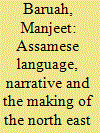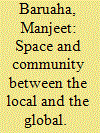| Srl | Item |
| 1 |
ID:
118928


|
|
|
|
|
| Publication |
2013.
|
| Summary/Abstract |
This paper is divided into two broad sections. The first section deals with the Brahmaputra Valley in Assam (north east India) and its transformation into a frontier in the nineteenth century. The section also deals with how this process was closely linked to the re-interpretation of the region's relationship with Indo-Gangetic culture, and the impact on development of the modern 'Assamese' language. The second section interprets modern Assamese novels in the light of the issues raised in the first section. It explores how issues such as indigeneity, the concept of India and modern Assamese language, share a relation of conflict in modern Assamese fiction. It is suggested in the conclusion that, due to such historical specificities, the language and narrative of the frontier require a specific regional approach, and should not be subsumed within larger frameworks such as 'the nation' or 'South Asia'.
|
|
|
|
|
|
|
|
|
|
|
|
|
|
|
|
| 2 |
ID:
140938


|
|
|
|
|
| Summary/Abstract |
Flood protection in the Brahmaputra's floodplains began rather late and was implemented precisely to protect the important commercial crop of jute. To begin with, in the early twentieth century, after a long wait and much speculation, action was finally taken to make the Brahmaputra's floodplains more productive to the British Empire. Soon the commercial production of jute began in the floodplains. This article explains how the Brahmaputra's floodplains were converted into the British empire's eastern-most jute frontier. The article also explains the political economy of flood management in Assam in the second half of the twentieth century. Further, explaining the shifting relations between state, capital, and floodplain, the article shows how these schemes achieved only partial success and at the cost irreversible ecological damage.
|
|
|
|
|
|
|
|
|
|
|
|
|
|
|
|
| 3 |
ID:
126658


|
|
|
|
|
| Publication |
2013.
|
| Summary/Abstract |
The objective of this article is to situate the relation between the local and the global in the context of a specific region formation, namely the Brahmaputra Valley of Assam in India as a frontier. The article takes up two examples on the relation between space and community construct and how the relation forms part of the deeper relation between the local and the global in the Valley. The Brahmaputra Valley comprises the major area of the Indian state of Assam. Assam and its neighbouring areas are also referred to as 'North East India'. The term came into use during the colonial period. It was used to refer to the British-Indian frontier which bordered on Bhutan, Tibet, China and Myanmar. In the first example of the article, the local-global relation is seen in terms of how the colonial-capitalism paradigm altered the pre-colonial socio-spatial relation, formulating and implementing new spatial and social classifications. The focus in the example is on the rearrangement of socio-spatial relations in the Valley as part of transforming a pre-colonial crossroads into a colonial frontier. In the second example, the relation between space and community construct is situated in popular responses to the above changes, and especially how international ideology like communism is appropriated to address the local specificity of frontier. The works of the cultural icon and peasant leader of the Valley, Bishnu Rabha, are discussed in detail. Through the interrelation between the two examples, the article tries to show how between the nineteenth and the mid-twentieth century the local specificity of the Valley as a frontier was possible precisely due to changes of state formation or ideology which drew on a global context. In other words, the relation between space and community construct in the Valley demonstrates how the coexistence of the local and the global was a necessary condition in its making as a frontier. Community constructs like 'tribe', 'Assamese' and 'Ahom' during the period formed part of this interrelation between the local and the global that
|
|
|
|
|
|
|
|
|
|
|
|
|
|
|
|